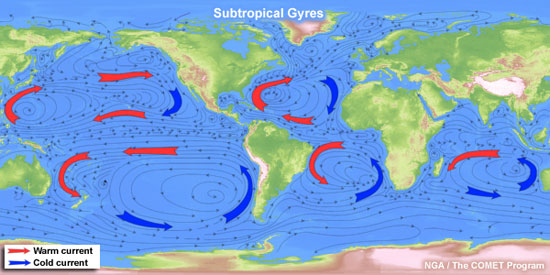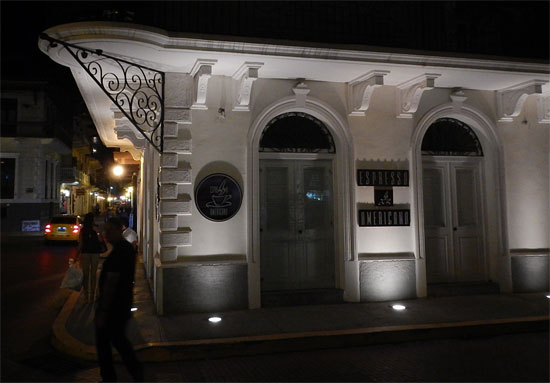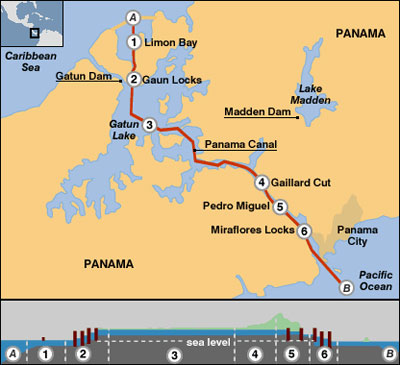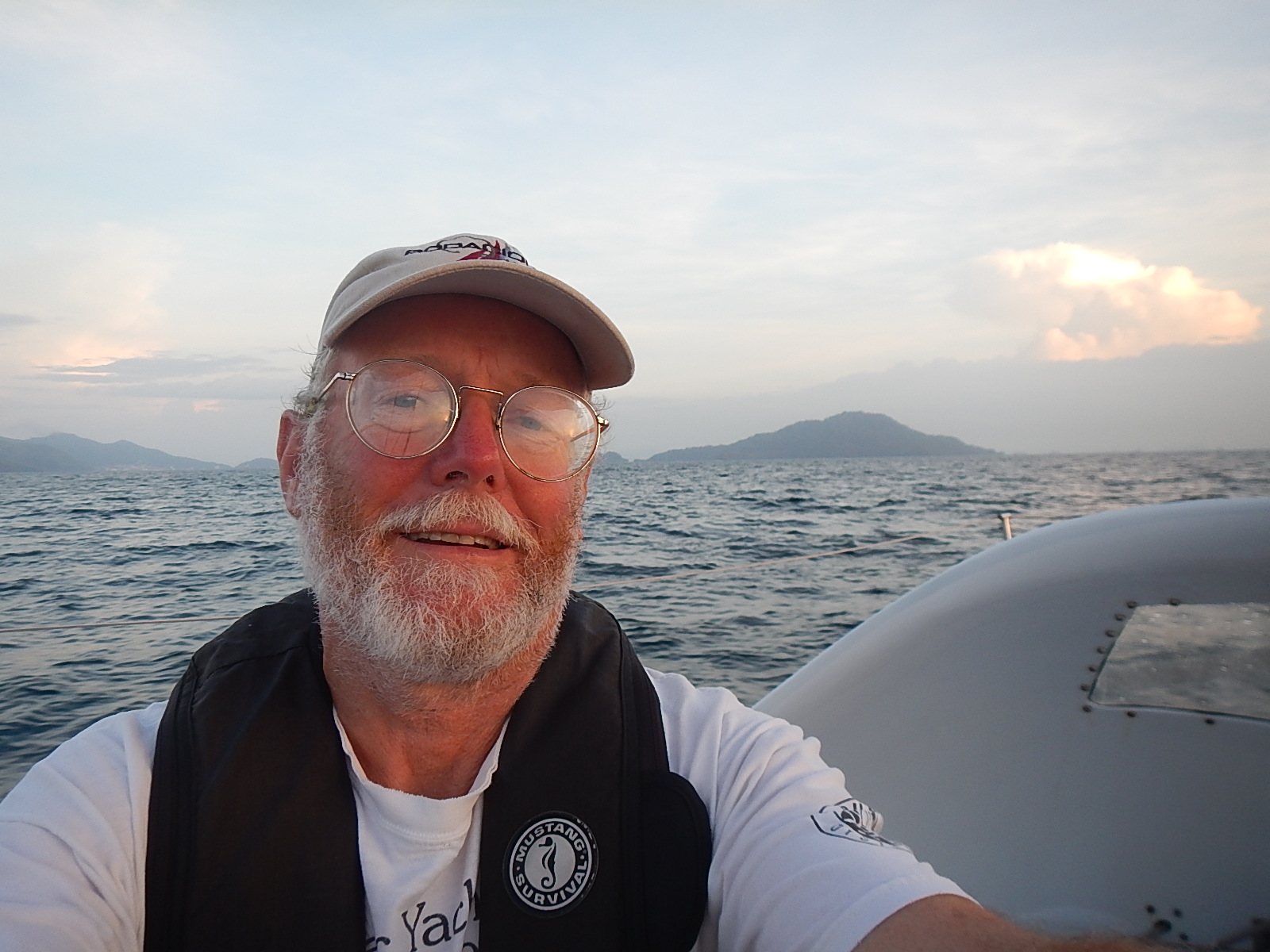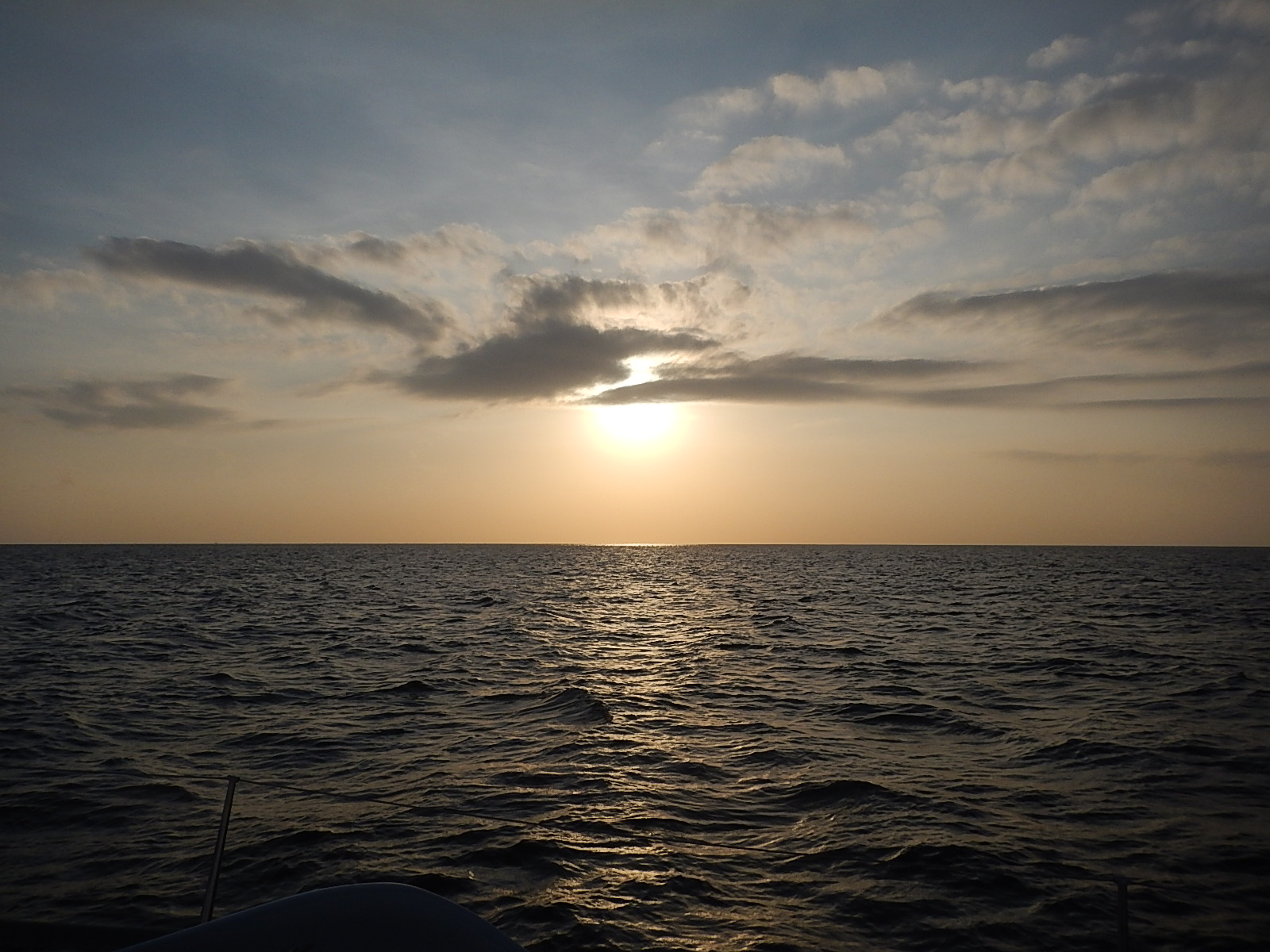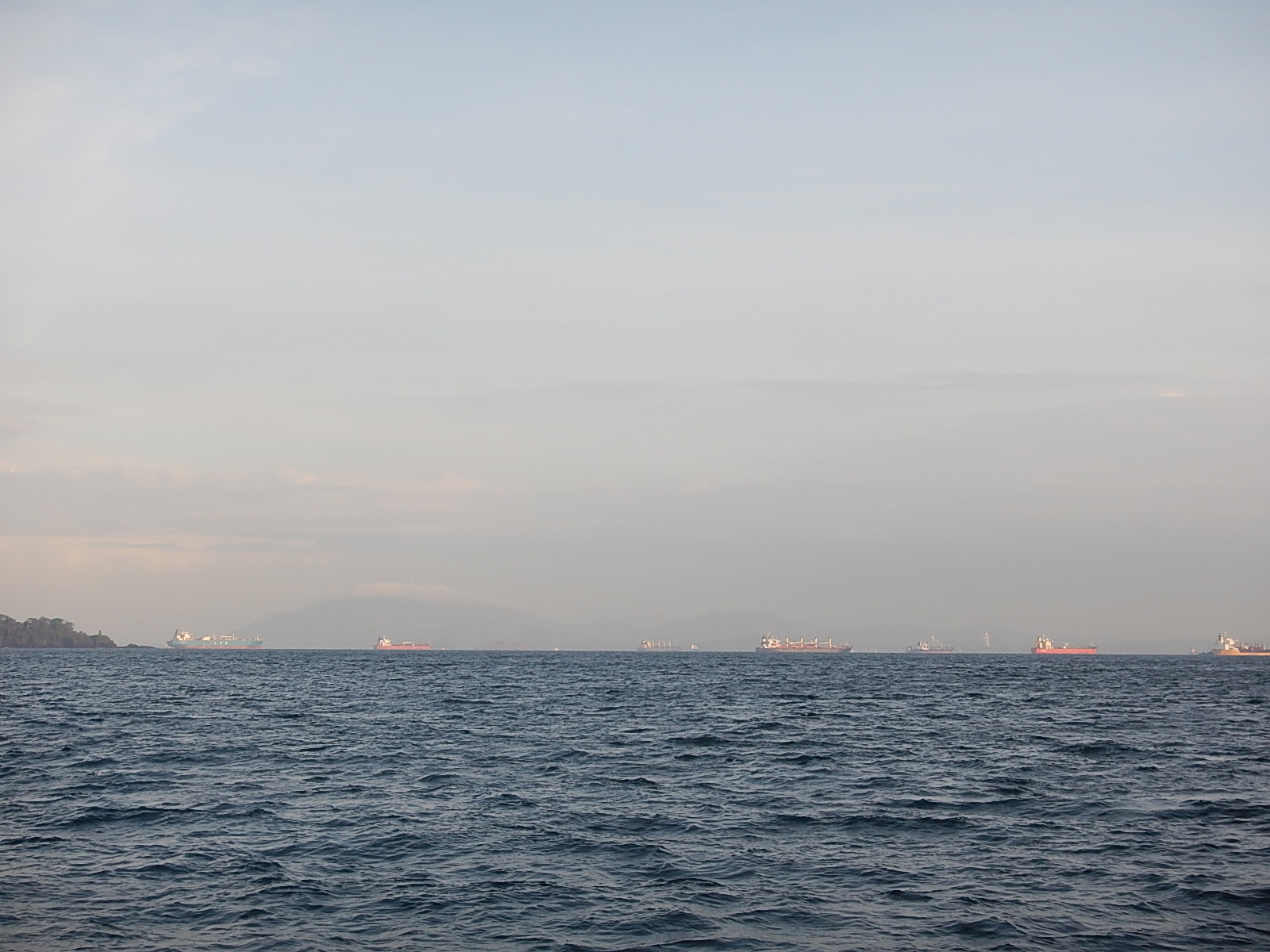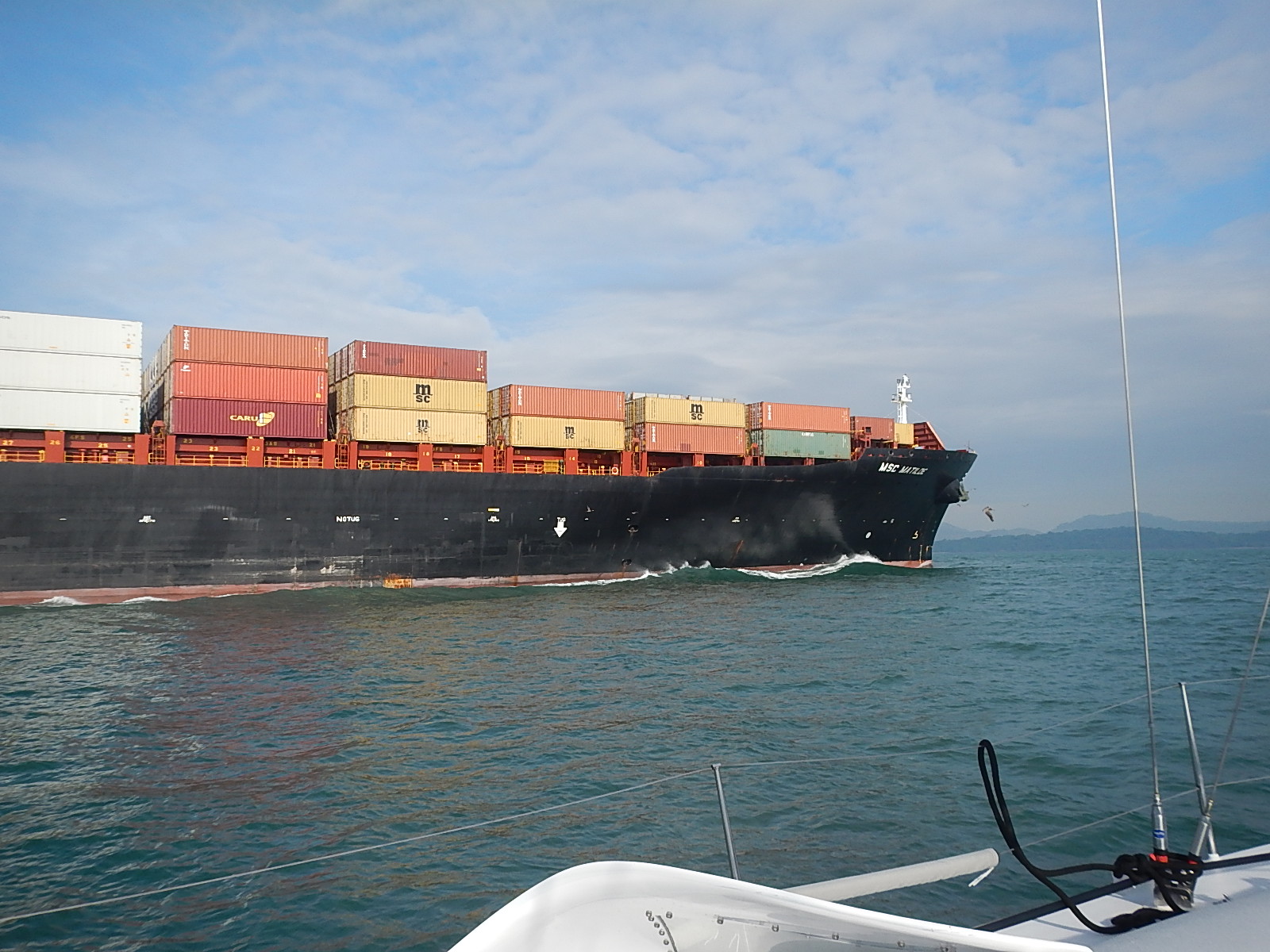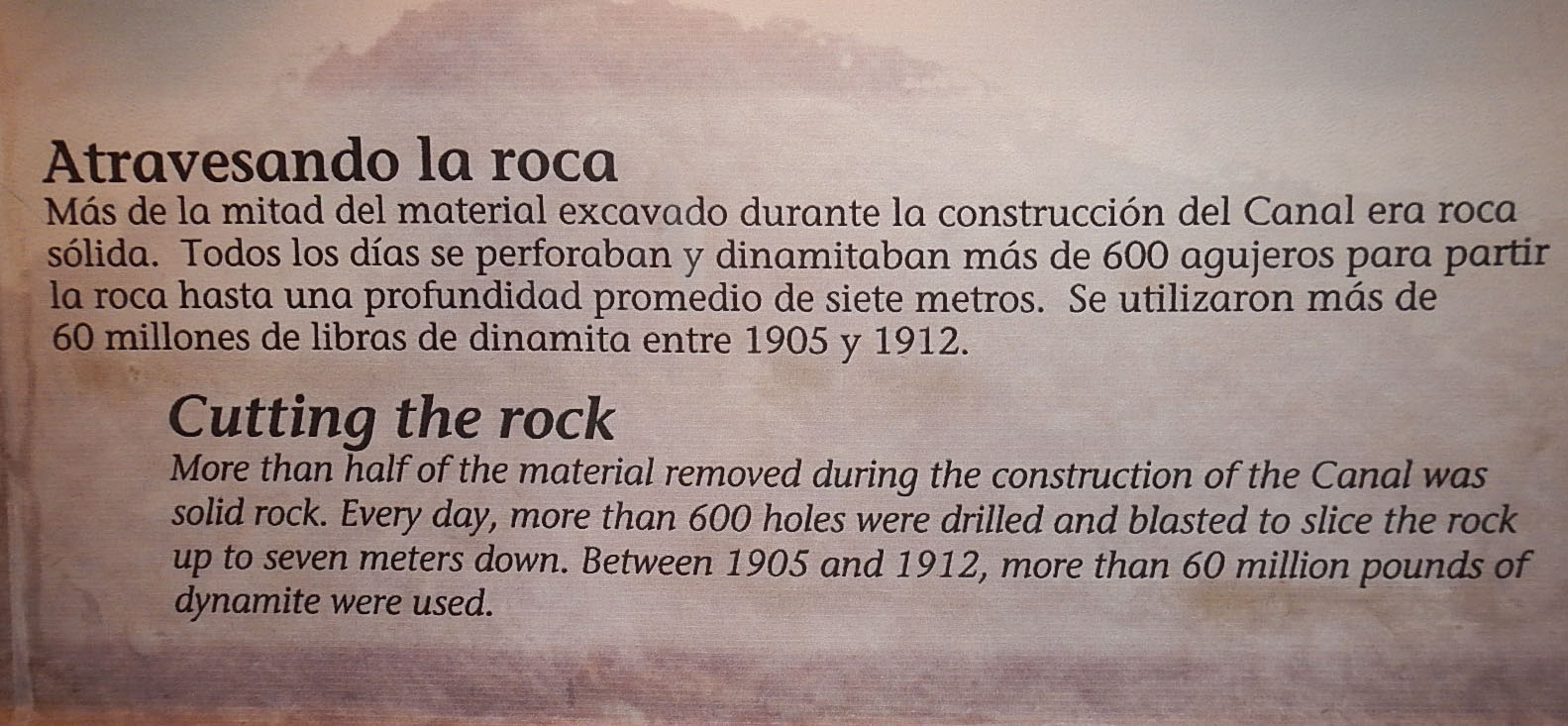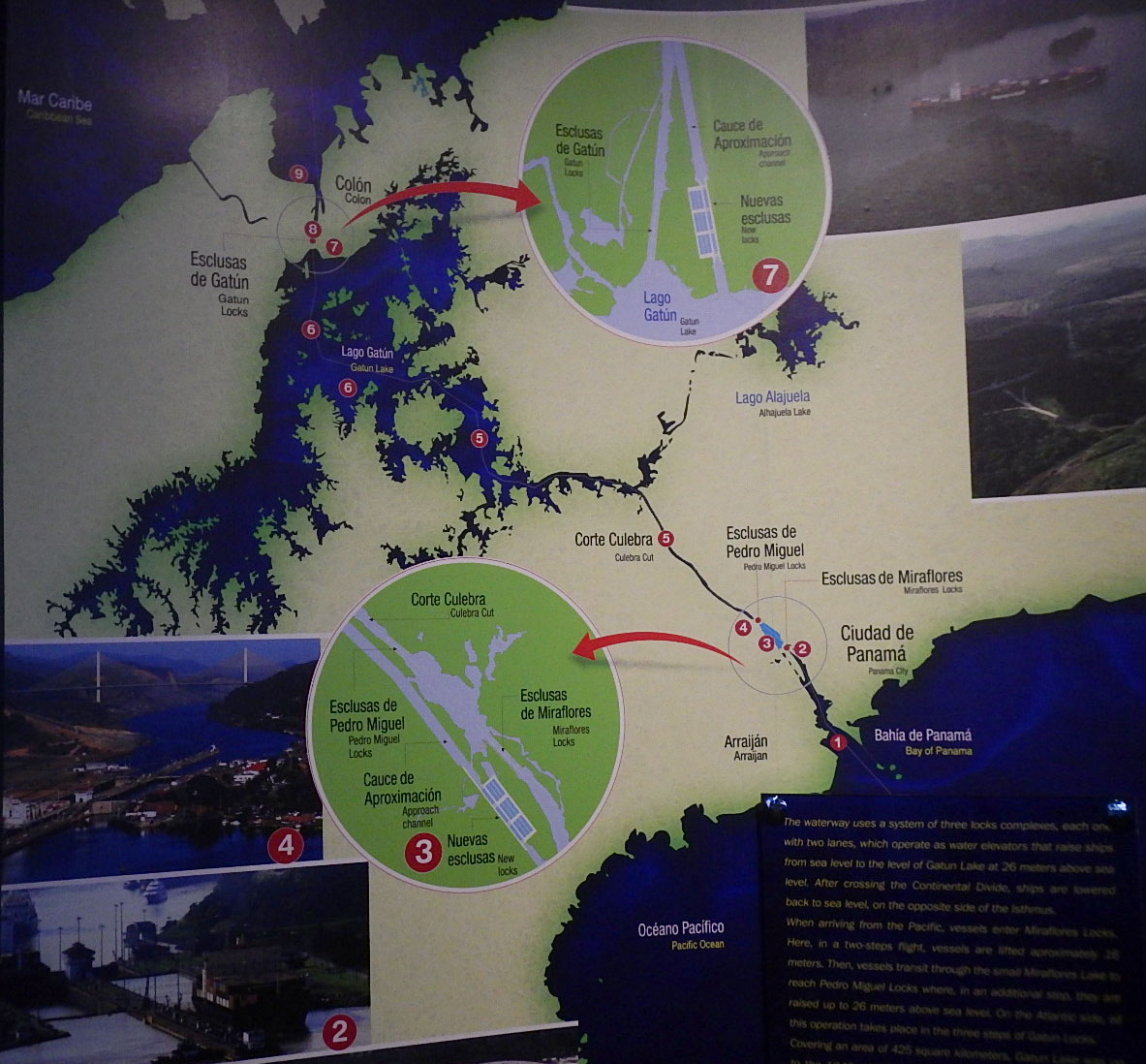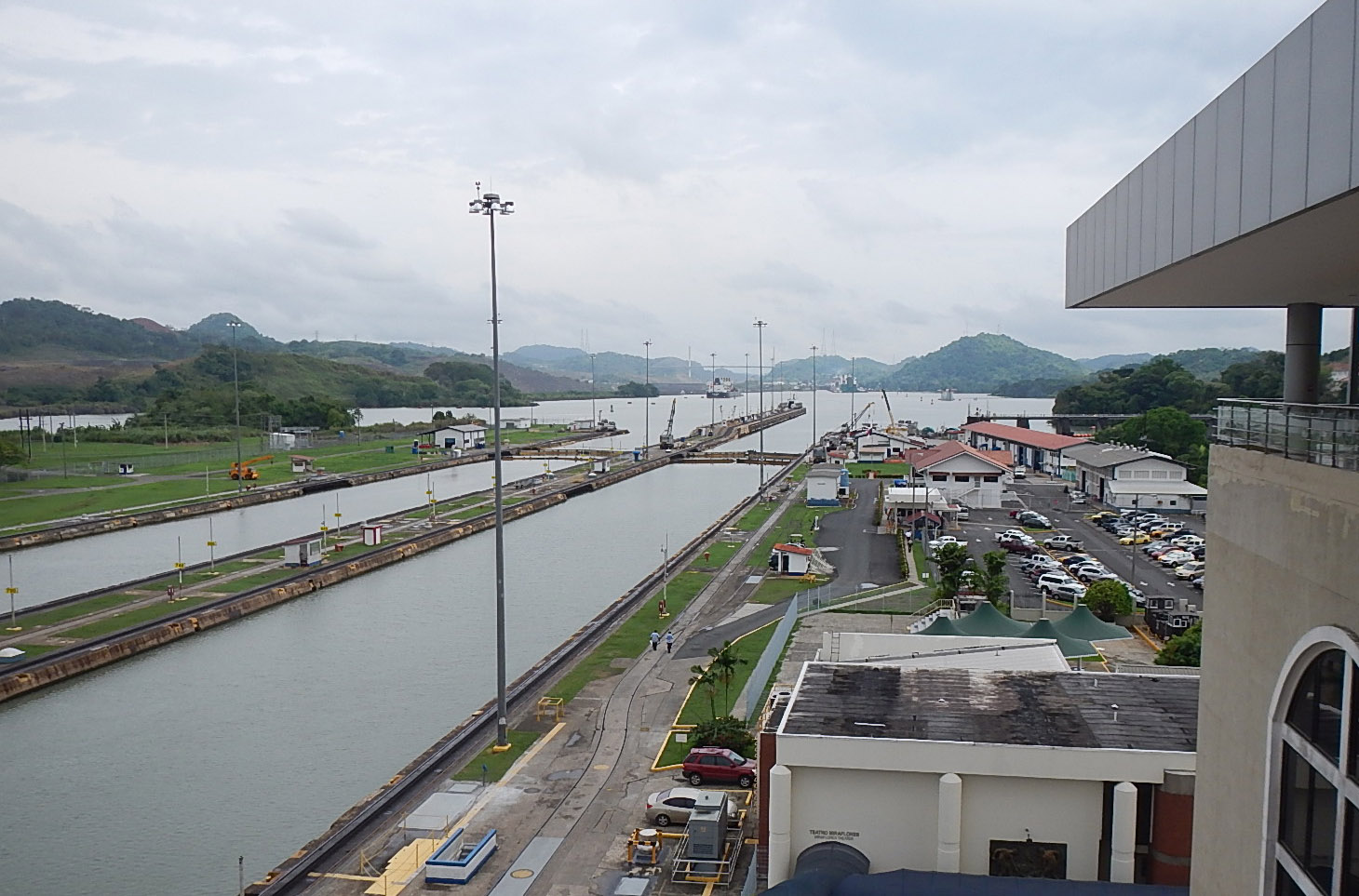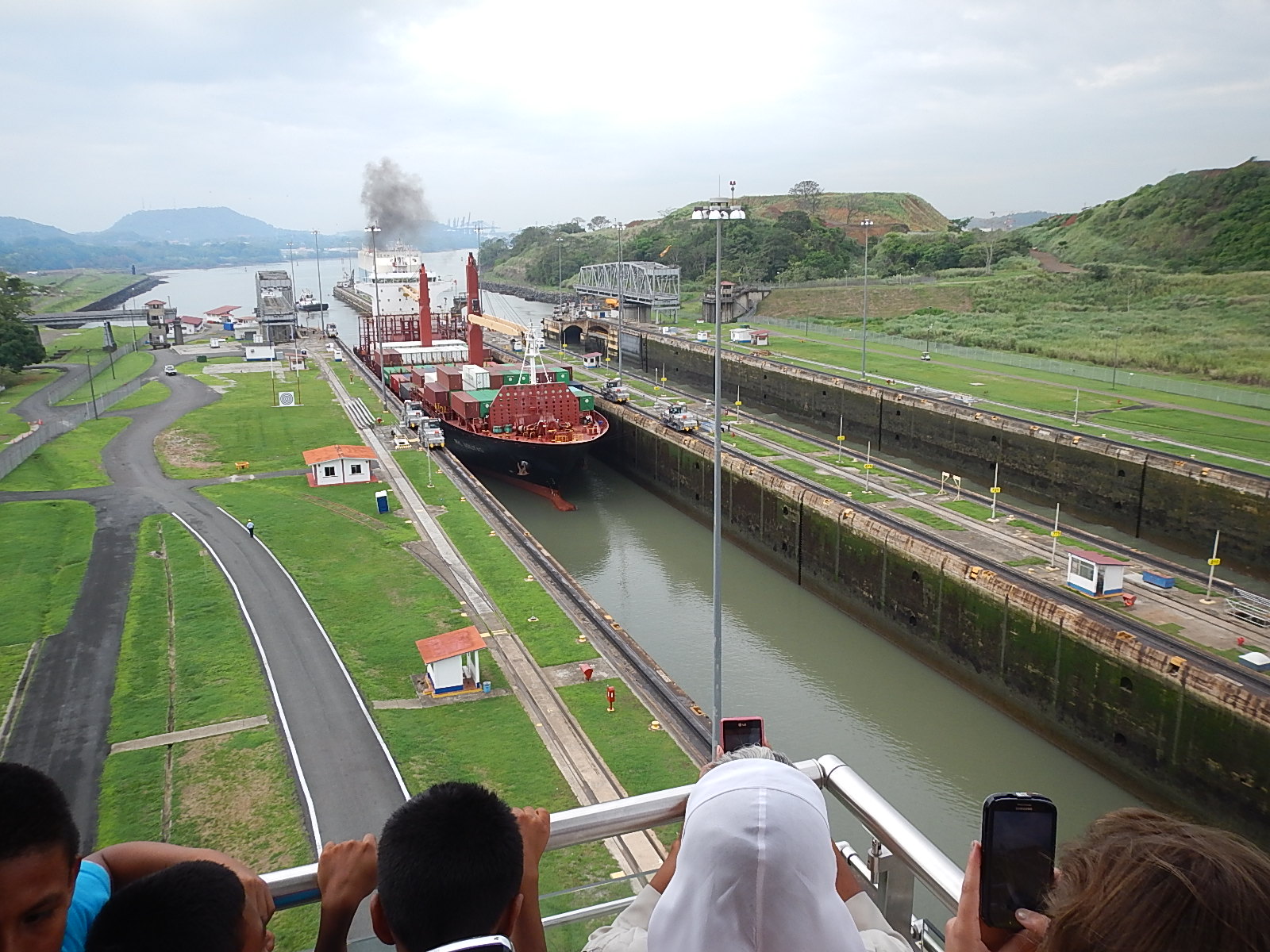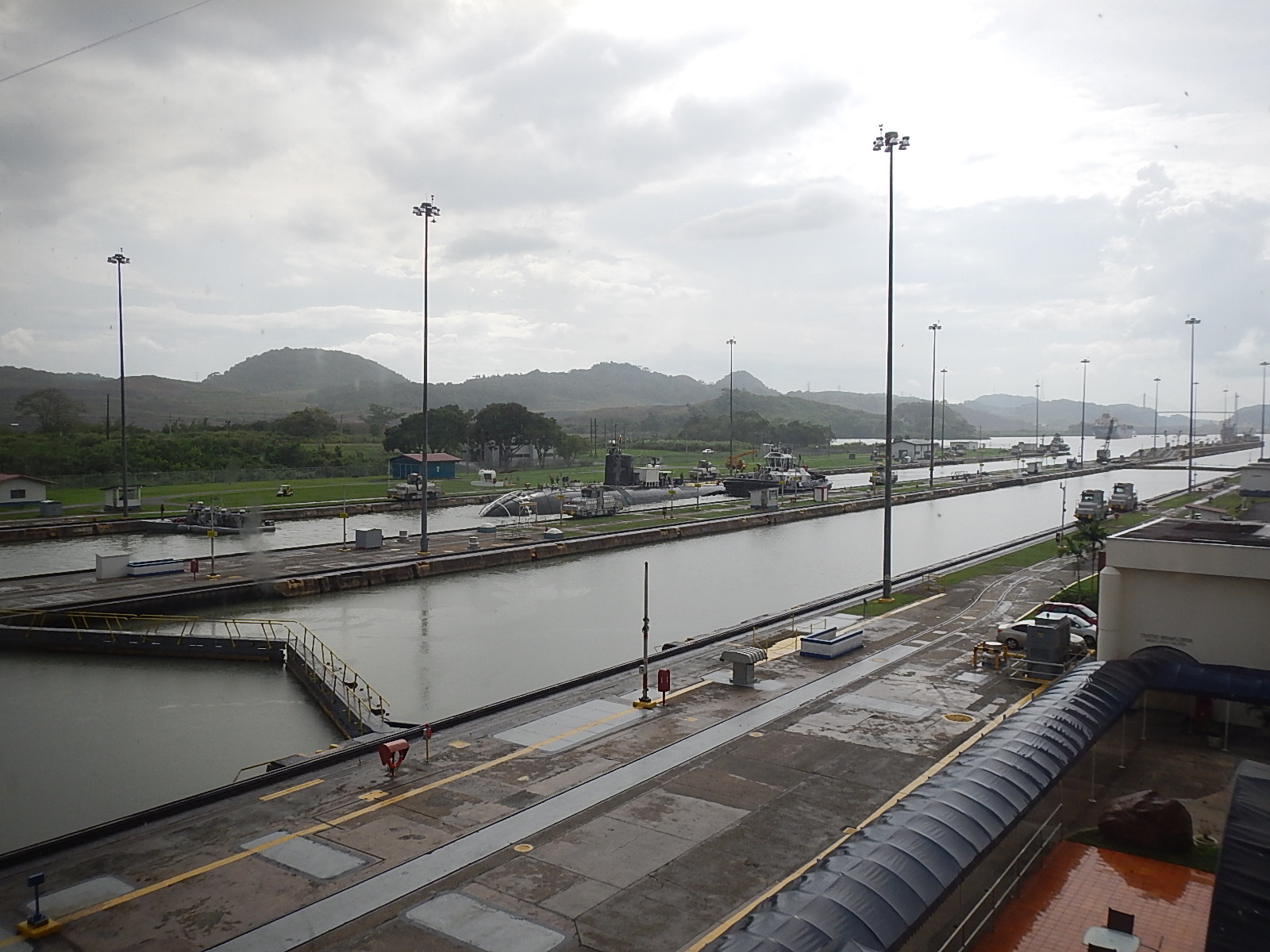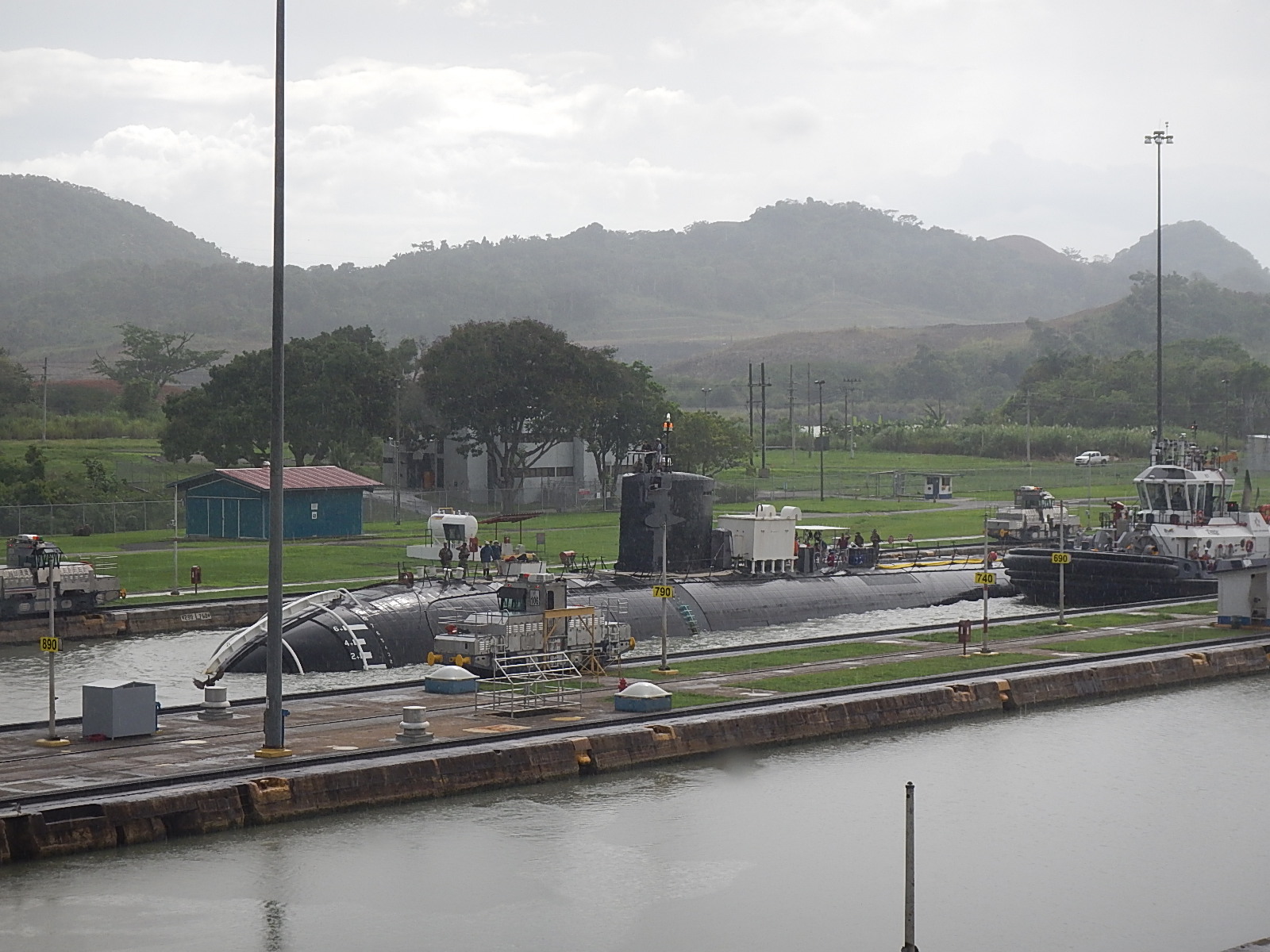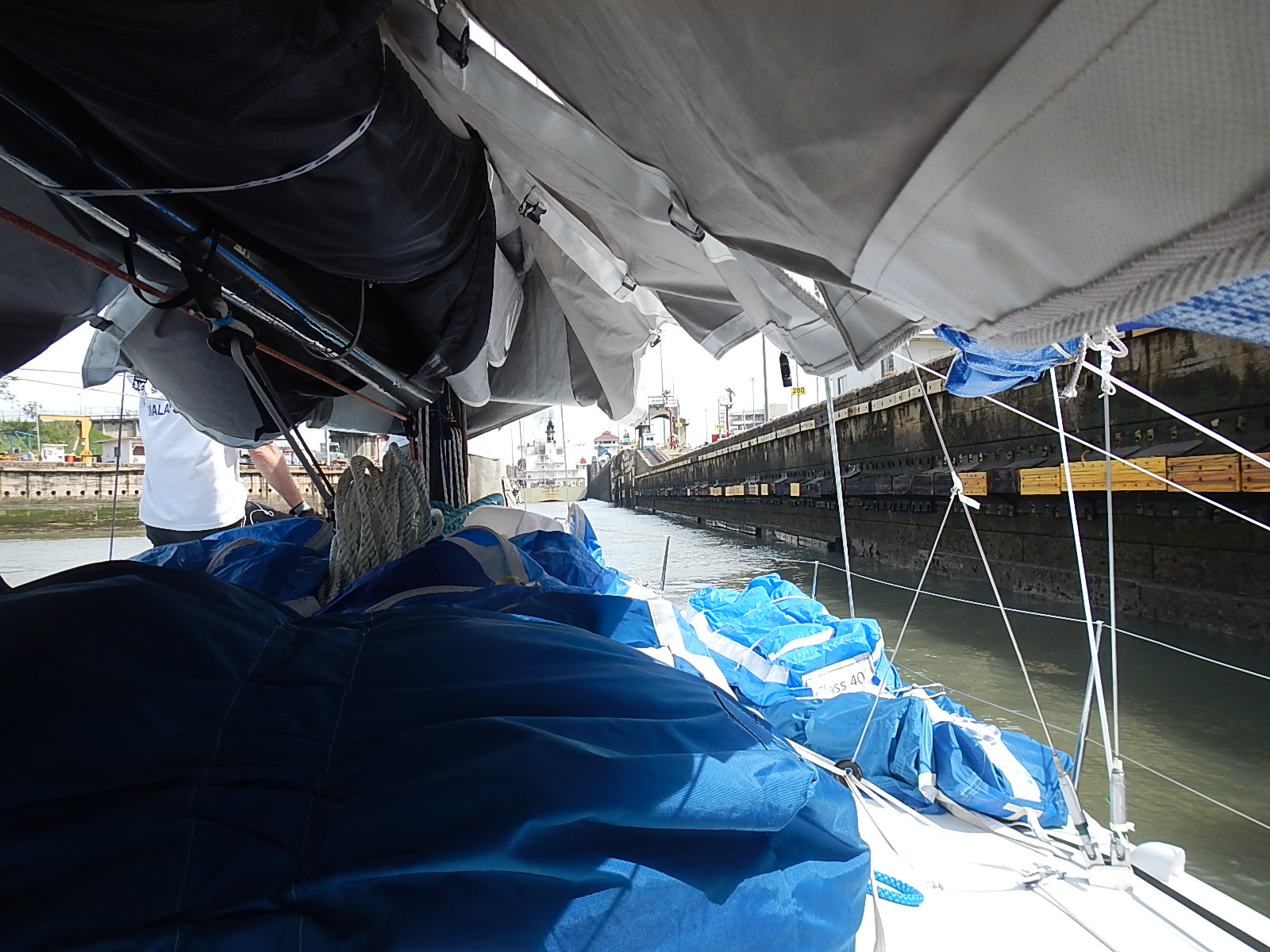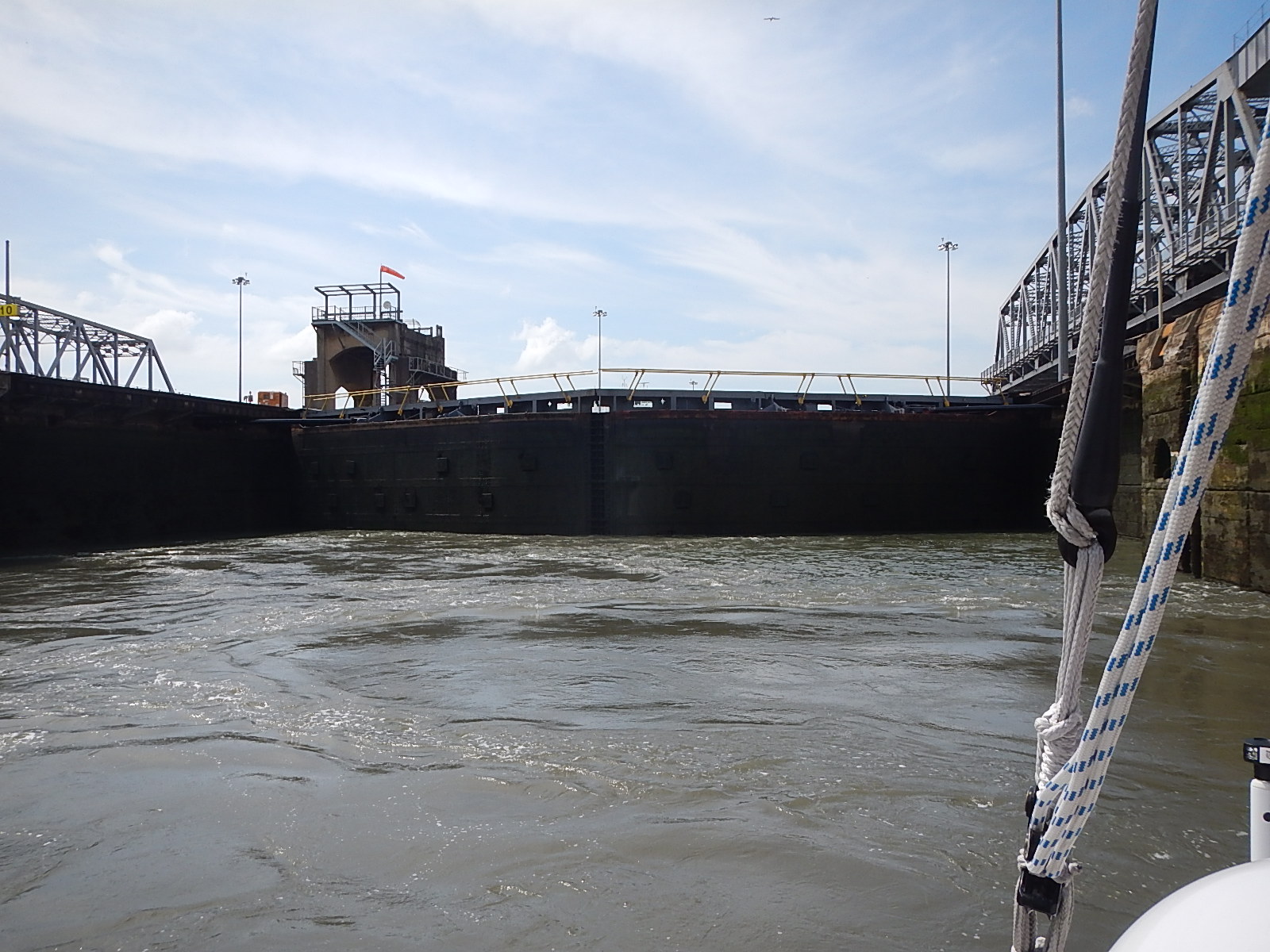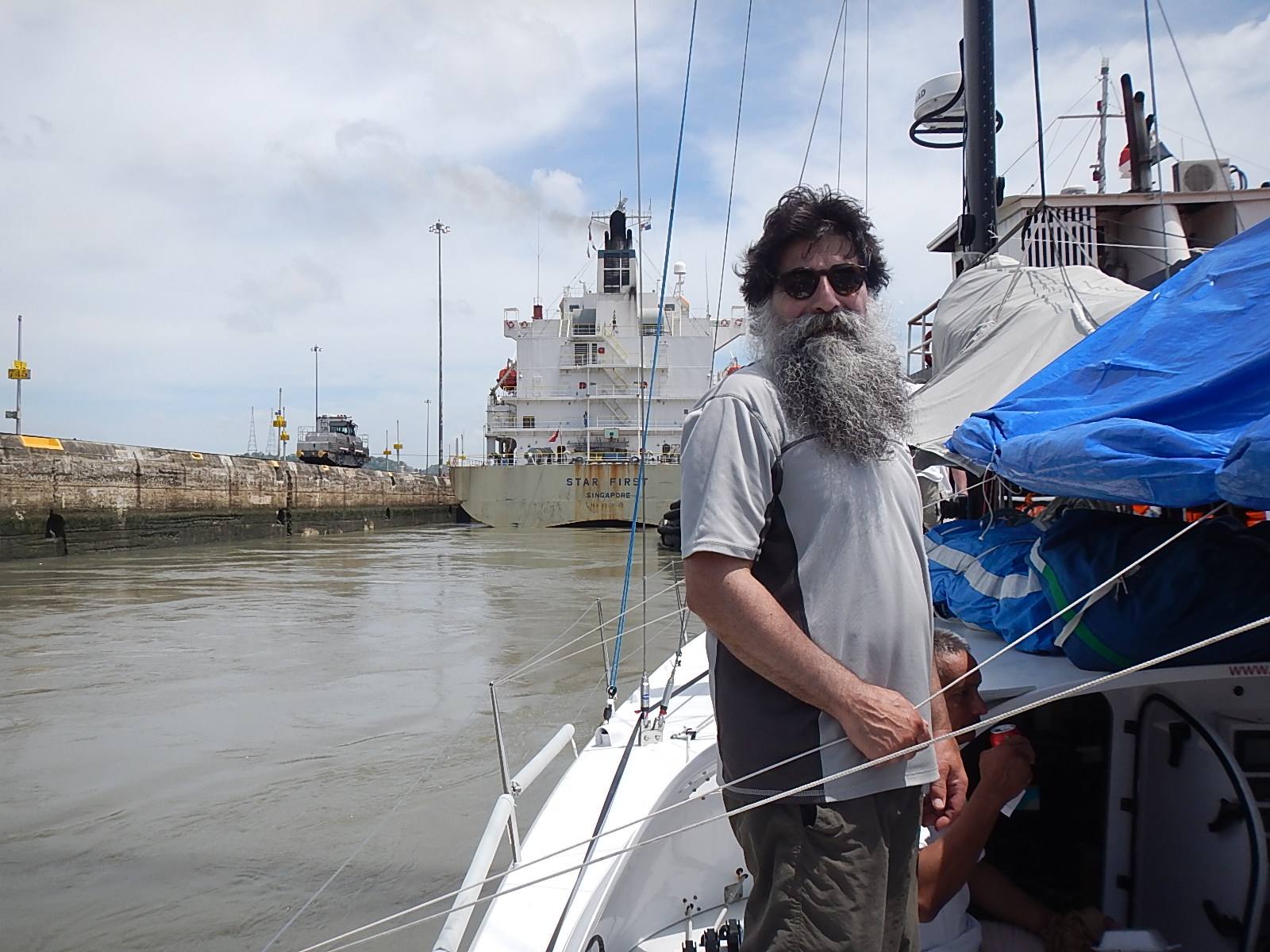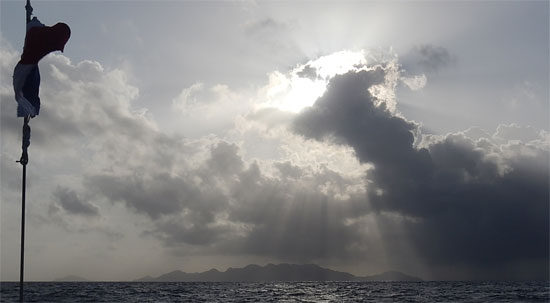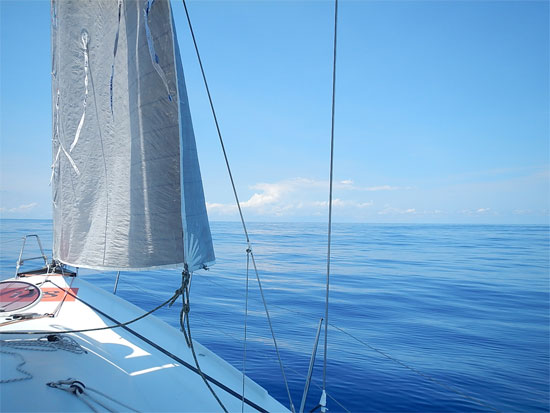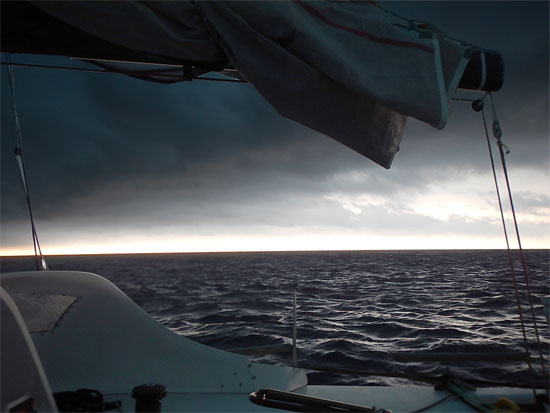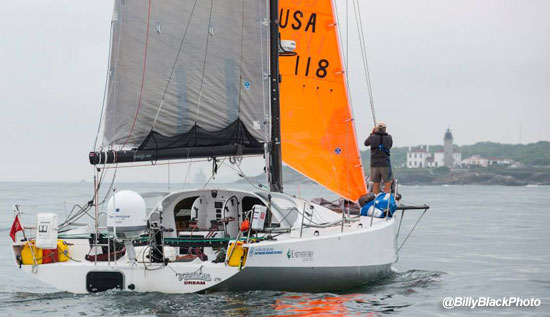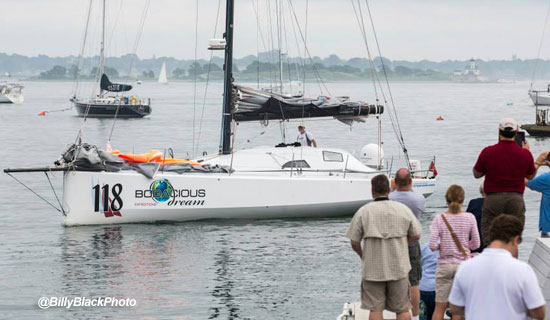:: LEG 4: May 7, 2014 – June 14, 2014
The Galapagos Islands – Newport, RI
(Miles/ Time: 38 Days)
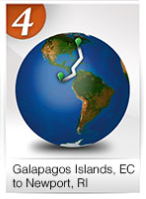 Once we had cleared Ecuadorian customs in the Galapagos and untied from our “new” mooring, I took the scenic route west and around the northern tip of Santa Cruz Island, before getting into open water and pointing Bodacious Dream towards the Columbian coast, which brought us into better winds and angles for sailing. After a few days, I gybed and began sailing north to Panama. The next five days of sailing were relatively uneventful … just solid days on the water. It was hot and sunny during the day, with some pleasant relief from the heat at night.
Once we had cleared Ecuadorian customs in the Galapagos and untied from our “new” mooring, I took the scenic route west and around the northern tip of Santa Cruz Island, before getting into open water and pointing Bodacious Dream towards the Columbian coast, which brought us into better winds and angles for sailing. After a few days, I gybed and began sailing north to Panama. The next five days of sailing were relatively uneventful … just solid days on the water. It was hot and sunny during the day, with some pleasant relief from the heat at night.
As we approached Panama, I noticed a significant increase in the amount of trash in the water. In the Southern Ocean, I could go days without seeing any debris. Now there was always a piece in view… and as soon as one passed behind me, another appeared in front of me. Sadly enough, even a used cigarette lighter was tossed up on deck by a wave splash! No doubt this is also related to the fact that the route to Panama is one of the most heavily-trafficked in the world.

Lots of big boys lining up near Panama.
:: The Great Gyres
Around this time, we also published an update on all the how floating debris cycles around the oceans in these great vortexes that we call the gyres. I had read a fascinating book called, Flotsometrics, that explained the science behind the mysterious flow of the gyres. It’s a great read … very engaging and full of great facts. If you’re at all interested, I think you’ll get a lot of it. You can read that whole update on the “harmonic” gyres right here!
:: Arriving in Panama
On the morning of May 14th, I requested clearance to enter the harbor at LaPlayita where I arrived at 08:15 in the morning. By 08:30, we were being inspected, measured and approved for transit through the Panama Canal, thanks to our very efficient and responsible agent, Francis with the Panama Agency!
Once in Panama, things moved along quickly. Beyond the procedures and inspections required before you can get clearance to transit the canal, I had to get the boat ready and also arrange provisions for my temporary crew of 4 – that number being a requirement of Canal Authority regulations. In this matter, I was one lucky skipper to have a great crew of four guys joining me for the passage – old friends who came down just for the passage – Pierce Johnson, Rob Plotke, Joe Yoffa and Bruce Dickinson.
We got to spend a few days together in Panama City, and found it a lively and cosmopolitan town. There is a great rejuvenation going on in the old part of the city where classic old buildings are being restored and renovated to accommodate stylish shops and fancy restaurants.
The day before our scheduled transit, we visited the Miraflores Locks. Viewing the locks from a visitor’s perspective, it was hard not to be impressed by the enormous scale of the project. What a monument to human industry and ingenuity – and completely mystifying when you realize it’s 100 years old this year! Imagine what it must have taken to conceive, design and construct such a thing.
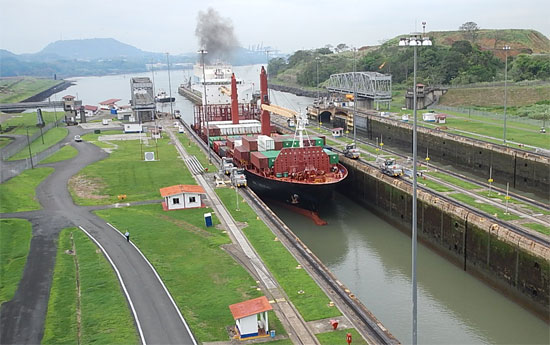 From the viewing deck at the Miraflores Locks – the day before our transit
From the viewing deck at the Miraflores Locks – the day before our transit
:: Day of the Crossing
On Saturday, March 17th at 7:30AM, we motored out to Buoy #6 and waited for the pilot boat to approach us, at which point Raphael, our pilot, hopped onboard and began giving us our orientation on how we would proceed through the canal.
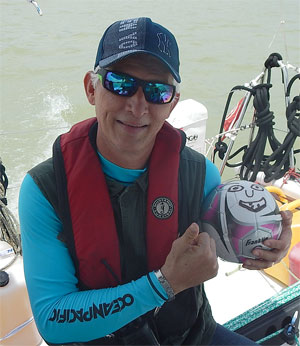 Rafael (pictured to the right getting acquainted with Franklin) told us we would be traveling through the first two sets of locks as a convoy with two other ships; one was a large (over 500 feet long) cargo ship from Singapore and the second, a smaller 95-foot passenger tour vessel named Islamorada, which it so happens, originally belonged to the Chicago gangster Al Capone!
Rafael (pictured to the right getting acquainted with Franklin) told us we would be traveling through the first two sets of locks as a convoy with two other ships; one was a large (over 500 feet long) cargo ship from Singapore and the second, a smaller 95-foot passenger tour vessel named Islamorada, which it so happens, originally belonged to the Chicago gangster Al Capone!
With much anticipation, we proceeded slowly up the channel, en route to meet the “big” ship and Islamorada.
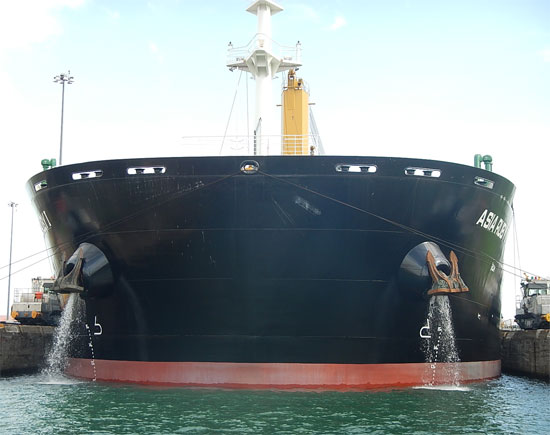
No question which of us was going to get the big bunk …
The term “lock” refers to these various sub-divisions of the canal through which you must pass. Each lock has chambers, which are like steps. So, the first lock (Miraflores) has two chambers. The big ship entered the chamber first, then Islamorada and then Bodacious Dream came in and tied alongside the Islamorada.
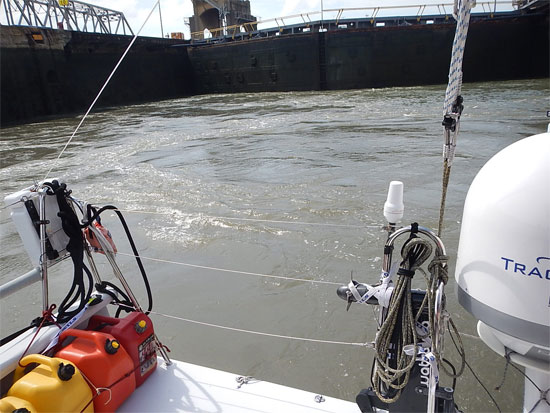
A bit of turbulence as the water floods in …
At that point, the gates closed and the chamber filled with 100 million liters (26.4 million gallons) of water, which had the effect of lifting all our vessels up to the level of the next chamber.
This process was repeated with the second chamber. There are two locks on the Pacific side; each with two chambers, which take you up to at 85 feet above sea level and release you into Lake Gatun – an artificial body of water in the middle of the isthmus. We then motored 21 miles across the lake. Once across it, we entered the single Pacific-side lock (which has three chambers) – which resulted in our descent to the Atlantic coast.
Here’s the first of two slideshows from the passage. Check it out. It was a totally unique experience!
SLIDESHOW #1
A second slideshow along with the full story on our Panama Canal crossing is right HERE!
You can also view all the photos in bigger formats as a photo album on our BDX FACEBOOK page … http://on.fb.me/1lBIbz3
:: Leaving Panama
Upon departing Panama, our course took us north towards the Yucatan passage that runs between Mexico’s Yucatan Peninsula and western tip of Cuba. Over the course of the week, we sailed through waters steeped in maritime history. This general region is named the Caribbean Sea, for the indigenous Caribe peoples. It was an area where many of the early explorers sailed and claimed new territories for their countries – most notably Spain, Portugal and France. You can easily see that old world Spanish influence in many of the Central American countries, along with the occasional French accent. Actually, construction of the Panama Canal was begun by the French! After Columbus’ initial “discovery” of the new world, his subsequent 4th voyage of 1502-03 came through the same area I traveled that first week out of Panama.

A map drafted for Columbus in 1490. Can you imagine navigating with that?
Calm seas cause a sailor’s mind to wander … and as I waited for the sliver moon and then the morning star to rise, I feel into a few reveries. In one, I found myself drifting back in time and imagining what it was might have been like to be an early explorer in these waters. I have the luxury of modern technology as well as the charts and notes of earlier sailors’ experiences to guide me; they had nothing.
When they would come upon an island unexpectedly, such as Providence Island, they would have to take great precautions not to end up on shallow reefs or rocks. They would often drop anchor quite a ways out and put a crew in a small boat to explore the area and coastline looking for an acceptable bay or harbor in which to anchor. The dangers were many; the buffers of safety few.
 After we arrived back in U.S. waters, Tegan Mortimer, our scientist colleague delivered a wonderful new Science Note (#11) on “Voyages of Discovery” that focused on course of scientific explorations that accompanied these early trans-oceanic voyages, beginning with Charles Darwin‘s journey aboard the HMS Beagle in the 1830s. That history of course continuing through the present day with the arrival of all sorts of exciting new technologies. She finishes with a beautiful call to join the scientific journey by taking up one of the many initiatives that comprise what we call “Citizen Science.” In fact, here are the sightings in the course of the circumnavigation that I made, all logged into iNaturalist. And here is our Citizen Science Resources page that is filled with great points of departure into the world of scientific discovery.
After we arrived back in U.S. waters, Tegan Mortimer, our scientist colleague delivered a wonderful new Science Note (#11) on “Voyages of Discovery” that focused on course of scientific explorations that accompanied these early trans-oceanic voyages, beginning with Charles Darwin‘s journey aboard the HMS Beagle in the 1830s. That history of course continuing through the present day with the arrival of all sorts of exciting new technologies. She finishes with a beautiful call to join the scientific journey by taking up one of the many initiatives that comprise what we call “Citizen Science.” In fact, here are the sightings in the course of the circumnavigation that I made, all logged into iNaturalist. And here is our Citizen Science Resources page that is filled with great points of departure into the world of scientific discovery.
:: Re-entering the Gulf Stream
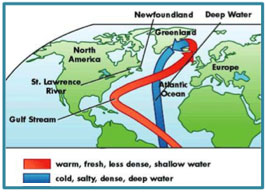 Another notable natural phenomenon of the area we sailed through that adds a great deal to its historical significance is the presence of the Gulf Stream. Around the tip of Cuba is where the Gulf Stream rises back to the surface and begins to drive currents north along the Florida coast and up the eastern seaboard to Cape Hatteras before it veers off across the North Atlantic towards Ireland and the British Isles. As it moves eastward, it cools, submerges and then travels, deep in the ocean like a conveyor belt, back to this region where, heated by the tropical sun, the current resurfaces once again.
Another notable natural phenomenon of the area we sailed through that adds a great deal to its historical significance is the presence of the Gulf Stream. Around the tip of Cuba is where the Gulf Stream rises back to the surface and begins to drive currents north along the Florida coast and up the eastern seaboard to Cape Hatteras before it veers off across the North Atlantic towards Ireland and the British Isles. As it moves eastward, it cools, submerges and then travels, deep in the ocean like a conveyor belt, back to this region where, heated by the tropical sun, the current resurfaces once again.
As Tegan Mortimer has shown us in her excellent Wind & Weather Science Note #2, the effect these powerful currents have on local waters when they converge with them help to create large and active zones for sea life to develop and thrive.
During this time, and before the “Voyages of Discovery” note mentioned above, we also published another Science Note (#10) from Tegan… this one on Tropical Marin Biododiversity. It’s a great one as well… that underscores the importance of these tropical latitudes in powering global currents and weather. She focuses in on coral reefs and on the multi-national effort to support Marine Protected Areas (MAPs). She also points us to some great research projects being conducted by our sponsors and friends over at Earthwatch Institute. Check it out at the link above.
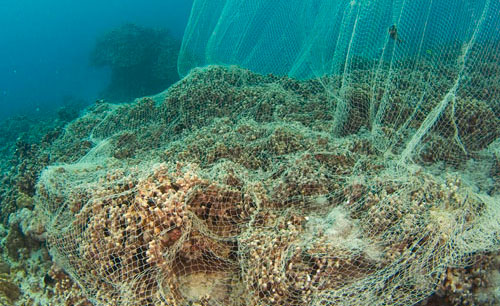
Rapid destruction of Coral Reefs is happening world-wide.
Meanwhile, as I traveled towards more familiar home waters, I met up with a mini-stampede of dolphins. What a thrill it was for me to have them fly alongside of us!
A Dolphin Stampede! (Here’s another shorter clip.)
Watching them leap skyward can’t help but take you back to what life on the seas was like before the arrival of all the techno-gizmos that we surround ourselves with today. Following these splendid creatures and their fluid movements reminded me how much has NOT changed in the eons of the gulf stream flowing, the trade winds blowing and the great cycle of marine life swimming – a comforting perspective for sure!
:: Returning to the U.S.
On May 30th, I pulled into Rybovich’s Marina in West Palm Beach after going through a line of thunder squalls. We commenced work on the mast which needed some maintenance to get her ready for the final run up the coast. I’m sure glad we did that, as the challenges we soon faced during three days of lightning and thunderstorms truly put Bodacious Dream to the test.
 While in Florida, we went ahead and published a series of interviews on sailing technology that I had conducted live and via email over the course of the voyage. The idea in support of our BDX Learning and Discovery agenda, was to interview some of my friends who are more knowledgeable than I in specific areas of new sailing-related technologies, specifically in the areas of Navigation, Rigging and Composite Technology.
While in Florida, we went ahead and published a series of interviews on sailing technology that I had conducted live and via email over the course of the voyage. The idea in support of our BDX Learning and Discovery agenda, was to interview some of my friends who are more knowledgeable than I in specific areas of new sailing-related technologies, specifically in the areas of Navigation, Rigging and Composite Technology.
I asked each of them to share with us how recent changes in technology are being applied to and altering ancient methods. If you are at all interested in the finer points of sailing, I highly encourage you to check out these interviews.
Here’s who and what we have.
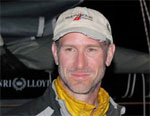
1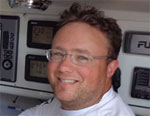 ) John Hoskins and Matt Scharl each tell us about advancements in sailing navigation systems
) John Hoskins and Matt Scharl each tell us about advancements in sailing navigation systems
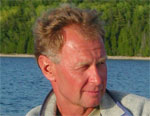 2) Alan Veenstra catches us up on new rigging technology, and how the principles of old are being modified by new lighter and stronger fibers and materials.
2) Alan Veenstra catches us up on new rigging technology, and how the principles of old are being modified by new lighter and stronger fibers and materials.
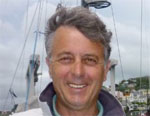 3) Finally, and in the longest interview, my good friend and chief builder of Bodacious Dream, Lapo Ancillotti takes us on a journey through composite materials technology.
3) Finally, and in the longest interview, my good friend and chief builder of Bodacious Dream, Lapo Ancillotti takes us on a journey through composite materials technology.
You can read these interviews at the links above.
Here’s a more video clip of a pod of False Killer Whales that came across my path just north of Cuba. Quite graciously, (though it may be hard for you to see) one of them flaps their tail a bit in what I understood to be a gesture of good luck for these final miles of my journey.
False Killer Whales
:: The Final Approach
The weather moving north from West Palm Beach was balmy and warm. The sun was extra hot during the day… pushing me to my cave below decks and out of the sun!
Then the weather changed quite dramatically, and I found myself smack in the middle of some full-on lightning and thunderstorms… and for three days straight!
I was excited to head north, and at the same time, a bit sad too at the approaching end of this journey. It’s been kind of like summer vacation from school. You want to see all your friends again, but you don’t want summer to end! Fortunately, summer is just beginning as I arrive in Jamestown and the U.S. which gives me plenty of great weather to look forward to.
As the picture above shows, there were a also a few days of very little breeze because of a couple of troughs of low-pressure systems. One of them though delivered a spectacular display of natural fireworks – lightning!
The lightning, the most I’d seen the whole trip, caused me a bit concerned about the possible damage that lightning might do to a boat like Bodacious Dream. So I invented some lightning grounding leads that might well have helped and certainly didn’t hurt.
I was excited as we headed north, but at the same time, a bit sad too at the approaching end of this journey. It’s been kind of like summer vacation from school. You want to see all your friends again, but you don’t want summer to end! Fortunately, summer is just beginning and I will arrive in Jamestown and the U.S. with plenty of great weather to look forward to.
As I traveled north, I couldn’t help but think about all the amazing people who have helped to make this great experience happen. There are a few too many to list here, but you can find their names in the June 12th post I titled “Oceans of Gratitude.”
Whatever thought I had of calmly finishing the voyage with easy breezes and calm skies fell away quickly as I kept running into more storm fronts.
Two days in a row delivered strong thunder and lightning storms mid-morning. Terrific rain, though not so much wind, only to about 35 knots – but tons of thunder and lightning! It’s incredible and beautiful to watch. At the same time, it clearly humbles you in the face of Mother Nature’s potential for fury! In such moments, it’s easy to imagine how such turbulent forces have over eons reshaped mountains, rivers and landscapes.
Finally on the morning of June 14th, I rounded Beavertail Point and motored into Jamestown Harbor, bringing to a close my single-handed circumnavigation of the globe.
It is hard to believe that this voyage is at a close. It truly did seem like only last month that I had slipped the docks in Jamestown, and now I am bringing to a close this around-the-world chapter of my life. What a time, what an adventure… what a journey it has been!
The whole story of the arrival and the gathering of friends and family who brought so much warmth to that day can be found here in a post called Where We Love is Home.
On my last night at sea, I suddenly became aware that I was being escorted by a dozen or so dolphins. They stayed with me for over two hours and just swam alongside… occasionally breaking the surface as they danced around. Perhaps they thought of me as a mother ship of some kind… or maybe they were just there under the light of the full moon to make sure I got home safely. Either way, the experience was amazing and quite moving for me.
In quieter moments, I’ve had a chance to reflect on the completion of this voyage. Quite the range of feelings for me to navigate there… from elation and excitement at nearing the end to restlessness and uncertainty when gazing into the future.
Several of my sailing friends have emailed to ask if I understand any better what was going through the mind of the great Bernard Moitessier as he approached the end of his circumnavigation, and decided rather than finish that historic 1968 race, that he would take off for Tahiti. He just wasn’t ready to return to “civilization.”
Anyway, my answer to the question posed by my sailor friends is yes, I most certainly have sometimes felt that way… I think this much time alone at sea changes you in ways that are not immediately apparent … and yes, I can now better understand why one might want to do such a thing… but as for me, it was time to go home!
It’s been nearly 9 months (256 days) since I left Newport on October 2nd of last year, outward bound around the world. Once arrived in port, it was time to allow my family and friends to help me celebrate this accomplishment that has taken me the better part of a lifetime to reach. I guess it just goes to show, if you really want to do something bad enough, you will find a way to get it done! Don’t let your dreams fade away.
So, for now, with that last quarter mile sailed and the journey around the world completed, a new journey begins – a more reflective inward journey to translate some of my thoughts and feelings about this miraculous world and its unfathomable oceans… as seen from the deck of a sailing ship. I will finally have time too to review all the many updates and stories that we told, all the science notes that we published and all the guides and tools to learning and discovery that were also such a big part of the expedition.
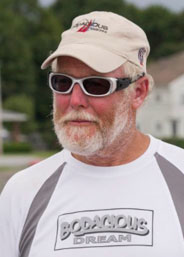 So stay tuned! There will be more photos and videos, and I’m sure I’ll have a few fresh perspectives to share with you as well.
So stay tuned! There will be more photos and videos, and I’m sure I’ll have a few fresh perspectives to share with you as well.
Thank you again one and all for your great kindness and unflagging support all along the course of this journey.
In gratefulness, I step back onto the shore of a new dream.
– Dave, Bodacious Dream & Franklin
:: All our 120+ updates from the water can always be found on the Expedition Blog… where they are filtered by subject and date. So, if you want to find something particular, select any of the categories or months in the search box, and the results will reflect your selections.
:: And all our Leg 4 photo albums will soon be found on our BDX Facebook Photo Album Page.
:: BDX Website :: Email List Sign-Up :: Explorer Guides :: BDX Facebook

